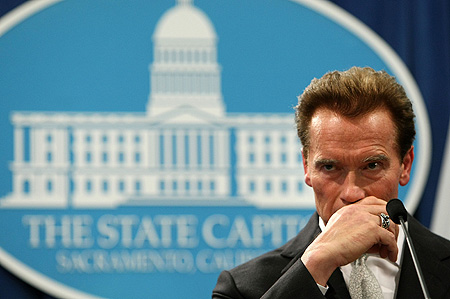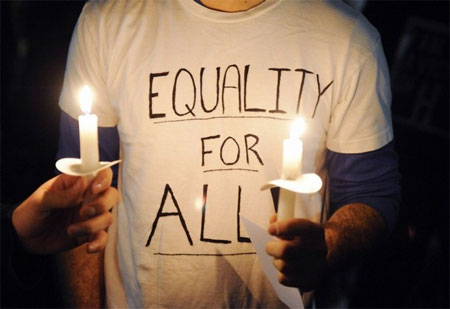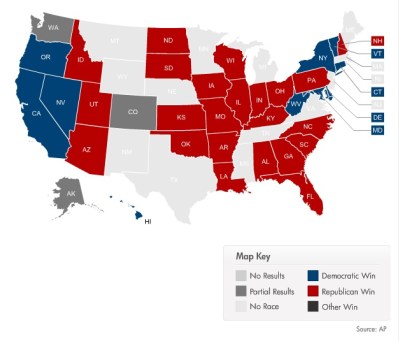How Bad Can Trump’s Administration Fuck With LGBT Legal Progress?
feature image via shutterstock
Were it possible to believe anything he said, it might seem reassuring that President-elect Donald Trump promised that marriage equality is settled because it was settled by the Supreme Court. Of course, anyone who has been paying attention is aware that his long history of shifting policy positions makes reliance on any particular statement functionally futile. Moreover, it’s hard to take him at his word, when he previously promised that he’d appoint a justice to overturn Obergefell v. Hodges, and when his published short list of Supreme Court nominees includes William Pryor, who went out of his way to argue in support of Texas’ anti-sodomy law circa 2003. Further, the idea that something is settled because the Supreme Court settled it runs directly contrary to his assertion in the same interview that Roe v. Wade should be overturned.
In the absence of a reliable agenda from the incoming administration, it is essential to understand the structural barriers to changing laws and policies. The ease with which rights and protections that we currently enjoy as a nation can be eliminated depends on how those rights and protections originated. When prioritizing worries, it’s essential to understand the relative security of different measures.
The Supreme Court and The Constitutional Questions
Although it may feel like the entire world shifted with the most recent election, as of this moment, the election does not fundamentally change the balance of the court. Although the President-elect will choose a replacement for Justice Scalia, this appointment is extraordinarily unlikely to alter the composition of the court, particularly on the most salient issues of the moment. Scalia ruled against equal marriage, and Scalia long held that the Constitution did not protect access to abortion. The promised ideological replacement can hold those exact same opinions, and nothing changes; equal marriage remains the law of the land, while abortion remains legal, but under attack.
Of course, this may very well not be the only Supreme Court vacancy during the next administration. Even if the Court composition were to change, though, and one of the stalwart liberal voices were to be replaced by a more conservative jurist, this would not signal an automatic loss of rights. Stare decisis, to stand by things decided, is among the most fundamental judicial principles; in the absence of a new or revised question, the court will typically defer to its previous decisions. Even a changing court would be required to reconcile any decisions with those that have come before. Ultimately the Supreme Court gets to select its cases and issue its opinions; it could choose to take any case and revisit any precedent, which leaves observers with limited predictive powers. Even with a revised Court, though, given the recency of the Obergefell decision and the clarity of the ruling, it seems unlikely that equal marriage will be revisited. However, as has long been the case, abortion rights will continue to be challenged; a change in the composition of the Court would not ensure that the fundamental right to abortion is overturned, but would put it in jeopardy.
Of course, ultimately, the Supreme Court is tasked with interpreting the Constitution; were the Constitution to be amended, the Court’s interpretations would change accordingly. Amending the Constitution is intentionally incredibly challenging, and despite recent calls for amendments, seems not terribly likely. There are two ways to propose an amendment: either Congress can propose an amendment, with two thirds majority support in both the House and Senate, or two-thirds of the state legislatures can call for a Constitutional convention. (Note that the second approach has never happened; as a practical matter, Congress does all of the calling for amendments). In either case, the proposed amendment must then be ratified by three-fourths of the States. This is not an impossible hurdle, but it’s certainly challenging, and therefore seems unlikely to become an issue over the course of the next administration.
Congress and The Legislative Questions
With control of the legislature comes control of the laws. Republicans control the House and the Senate, and will control the legislative agenda; for those concerned about traditionally Democratic causes, the next few years are likely to be heartbreaking. Progressively-inclined people might have taken a bit of solace in Mitch McConnell’s assertion that it is important not to “misread [the] mandate,” before remembering that if Mitch McConnell is the voice of reason, standards have changed dramatically. From a structural standpoint, there are three checks on legislation: Republican party infighting, the Constitution, and the Democratic minority. Although these factors might slow the pace of regression, the harm is likely to be tremendous.
As concerns go, the Affordable Care Act lives at the top of the list for many people. Republicans have been fighting to overturn the ACA since its inception, and they no longer have a President with veto power standing in the way. Given the rhetoric, it seems almost inevitable that the ACA will disappear. For the 22 million people who are at risk of losing health insurance with repeal, perhaps the most important question is what will come to replace it. There’s no consensus or clear vision at this point. Several policy proposals have been released, offering reduced benefits at reduced costs; however, the scope of the reduction could vary tremendously, depending on which faction of the Republican party gains momentum.
Beyond overturning existing laws, though, the potential for new and abhorrent laws feels nearly limitless. The Democrats aren’t obstructionist enough to filibuster every proposal in the next two years, which means that they will likely have to accept bitter compromises to move anything forward. Equal marriage may be settled, but so-called religious liberty laws seem ripe for action at the Federal level, in a world where the Republican party has such limited opposition. (The debate is already underway; up until last week Republicans were pushing the Russell amendment, which would have expanded religious exemptions to existing discrimination laws. The amendment is dead, but the sentiment is not, and this sort of legislation is likely to reappear in the future).
The Presidency and Executive Actions
The Presidency comes with tremendous power, and in the face of Congressional inaction, President Obama has used his executive powers to advance a progressive agenda, protecting transgender federal employees from workplace discrimination and granting limited protections to children who arrived in the US without documentation. However, this is the area where any protections are least secure; the incoming President can revoke every executive action as readily as President Obama could issue them, and likely will.
The President-elect has pledged to revoke all “unconstitutional executive orders,” but it’s impossible to understand what this means, exactly, as unconstitutional seems to be a standard established in his mind. The Presidency comes with many powers, but the Supreme Court still serves as the fundamental arbiter of whether actions are unconstitutional. Regardless, in this context, unconstitutional is a marketing statement rather than an objective classification, and either way it doesn’t matter. The President-elect can revoke any executive action he wants.
In addition to the power to issue and rescind executive orders, the President selects the leadership and sets priorities for the administration. The current administration has taken a number of positions supporting the LGBT community, from refusing to defend the Defense of Marriage Act (before the Supreme Court deemed the law unconstitutional) to asserting that prohibitions against sex discrimination in the Civil Rights Act of 1964 encompass claims of discrimination on the basis of gender identity.
Recently, the Supreme Court agreed to hear oral arguments in the Gloucester County School Board v. G.G. case, regarding the right of a transgender student to use the restroom consistent with his gender identity. Among the central questions is the extent to which the Court should defer to the administration’s guidance on this subject. However, if the new administration were to revoke the guidance at issue in advance of the oral arguments, this question would be rendered moot. In that situation, the Supreme Court may address the substantive issue, or may send the case back to the lower court, leaving the fundamental issue to be resolved another day.
The new administration will have equal opportunity to establish policy priorities, but there is little reason to believe that protecting the LGBT community will be among these priorities. In turn, a void in leadership at the Federal level may create greater space for State legislatures to enact harmful laws, such as laws restricting access to bathrooms or allowing businesses to discriminate against queer people.
The legal landscape is bleak. At least for the immediate future, the Supreme Court will continue to provide an institutional check — but the Legislative and Executive Branches move more quickly, and the short-term damage to families that are torn apart and people who lose access to health care will be irreparable. Some States may move forward with protections for the LGBT community, but a fragmented State approach leaves many without protections.
Despite the political challenges, and the very real ways in which policy decisions affect people, now is not the time to become despondent. The potential for such a regressive Federal government seems so disheartening because of the tremendous progress over the past few years, but the administration does not control and cannot contain the progress. Now is the time to take protective actions and organize, and to support those organizations that will help in the battle. In the words of the late, great Senator Paul Wellstone: “Stand Up! Keep Fighting!”
The RadRight And The Restroom
The Rhetoric
If you’ve not yet heard, discourse surrounding trans equality has been reduced to arguing about whether or not men should have access to the women’s restroom. Trans equality measures have been dubbed “bathroom bills” by radical right propaganda mills and the media has, of course, picked up their meme. Here are some quotes:
+ “Bathroom Bill Sparks Transgender Rights Debate in AZ” – SouthFloridaGayNews.com
+ “Arizona Transgender Bathroom Bill OK’d by State House Panel” – Huffington Post
+ “Arizona considers anti-transgender bathroom bill” – Telegraph.co.uk
+ “Critics denounce Bill C-279 as “The Bathroom Bill,” claiming it will allow “sexual predators” to commit “violent and sexual attacks” in public washrooms.” – Toronto Star
+ “A resolution offered by Penta referred to the law officially titled An Act Relative to Gender Identity, which was passed by the state Legislature in 2011 and took effect last July, as the “Massachusetts Stealth Bathroom Bill.””– Boston Globe
The RadRight has enjoyed a long and successful history of standing in the way of equality through deploying what I call the Bathroom Meme. Whether it was standing in the way of desegregation, the Equal Rights Amendment or Don’t Ask, Don’t Tell, the RadRight always deploys this particular meme.

1977 Post Mortem on ERA
The above story is worth a read. It’s a glimpse into the very playbook the RadRight is currently using against trans equality. (NOTE: When this article uses the term “integrate,” it is talking about allowing men access to the women’s restrooms under the cover of an equality law.)
Here’s just a few quotes:
“Listening to the opponents of the Equal Rights Amendment, you would think it was designed to… integrate public toilets, legalize rape, outlaw heterosexual marriage… Law professor Paul Freund objected in 1973 to being ‘quoted erroneously and out of context by certain opponents of the Equal Rights Amendment’ and commented flatly, ‘I have not staled, and I do not believe, that the Amendment would require the sharing of restroom and prison cells by both sexes.’ Yet in 1975 a huge anti-ERA advertisement in Baton Rouge papers credited him with the allegation that the ERA would integrate bathrooms. “ – Ruston Daily Leader, Thursday, June 16, 1977
This 40 year old newspaper article succinctly exposes the reason the RadRight injects the Bathroom Meme into public discourse:
“The hubbub over the implementation of the Amendment is designed to elicit a knee-jerk reaction…”
Remember this because I’ll revisit the notion of a “knee-jerk reaction” a bit later. Contrast the RadRight’s 40 year old rhetorical MO to the way they frame trans equality today:
[yframe url=’www.youtube.com/watch?v=n7dBdZJAS7c’]
Even if you weren’t around back in the 1970s, the RadRight’s arguments should sound familiar to you because they used it against repealing Don’t Ask Don’t Tell:
“Most concerns we heard about showers and bathrooms were based on stereotype— that gay men and lesbians will behave as predators in these situations, or that permitting homosexual and heterosexual people of the same sex to shower together is tantamount to allowing men and women to shower together.” – Pentagon’s report on ‘Don’t Ask, Don’t Tell’, page 13
It’s worth noting that the Pentagon’s report goes on to pick apart the various arguments from tradition (page 94) that so frequently accompanies the Bathroom Meme. Consider the way this fallacy accompanied the Bathroom Meme when the RadRight rolled it out against racial equality half a century ago:
“Angry white CIO steelworkers today sought a national union order ending racial segregation on union property… CIO officials several days ago issued instructions to all local unions to do away with separate toilet, fountain and locker room facilities for whites and negroes. Some… told him they would not stand for “Southern traditions being torn down.” – The Tuscaloosa News – May 26, 1950
While we’re talking about the Restroom Meme and racial inequality, nowadays the RadRight is quick to assert that gender equality and civil rights are completely different issues. However, the historical reality is that the Bathroom Meme was deployed in support of both race and gender inequality:

3/25/1973, The Anniston Star: Men in the women’s restrooms
“If they can integrate restrooms on the basis of race, why not on the basis of sex?”
For a more in-depth review of the way the Bathroom Meme was used against equality, check out Justice and Gender: Sex Discrimination and the Law.
The Rationale
What are the forces of anti-equality hoping to communicate with their propaganda? Are they claiming that because a rapist puts on a snappy wig they might get away with it due to equality laws? Are they suggesting that equality protections somehow condones abhorrent behaviors like rape? Well, yes… that’s the basic argument anti-equality forces are making.
They hope that the revulsion you naturally feel about sexual violence will shut down your critical thinking abilities. Their rhetoric is specifically designed to elicit a knee-jerk reaction in you. They hope that instead of thinking of rapists as being the threat, you’ll instead see trans people (or gay people) as being the threat. Because, if they can get you to do that, the process of vilification and dehumanization will begin and trans people as a whole will naturally seem like a group who should be treated with suspicion. If they can get you to do this mental gymnastic, there will never be any need for them to produce objective evidence which explains exactly how equality laws nullify existing laws prohibiting rape, assault, stalking and/or public indecency/disturbance. No, with the anti-equality blinders on, the risk trans people pose will seem self-evident just as being gay was a risk that seemed self-evident at one time.
https://www.youtube.com/watch?v=-AXAOT_swIE
(Note the way homosexuality is framed in this news piece. How similar does this propaganda sound to the way trans issues are framed by the RadRight today?)
When dealing with those who are appealing to the Bathroom Meme, I respond by simply asking, “In what way does gender equality nullify laws prohibiting rape, assault, stalking and/or public indecency/disturbance?” They never seem to have a reasoned response. While they’ll rhetorically tap dance all over the place, the one thing they’re never able to do is explain precisely how gender equality nullifies laws prohibiting rape, assault, stalking and/or public indecency/disturbance. When pressed, they’ll even resort to lying:
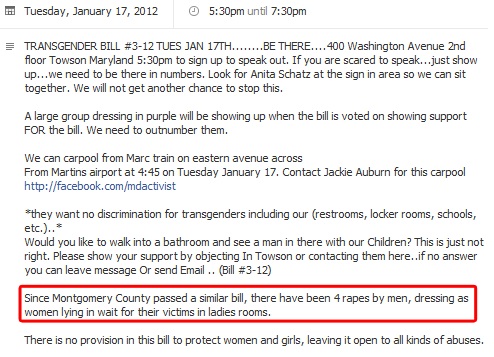
“Since Montgomery County passed a similar bill, there have been 4 rapes by men, dressing as women lying in wait for their victims in ladies rooms.”
Really? Four rapes you say? Well, let’s see what law enforcement has to say about that testable assertion of fact:
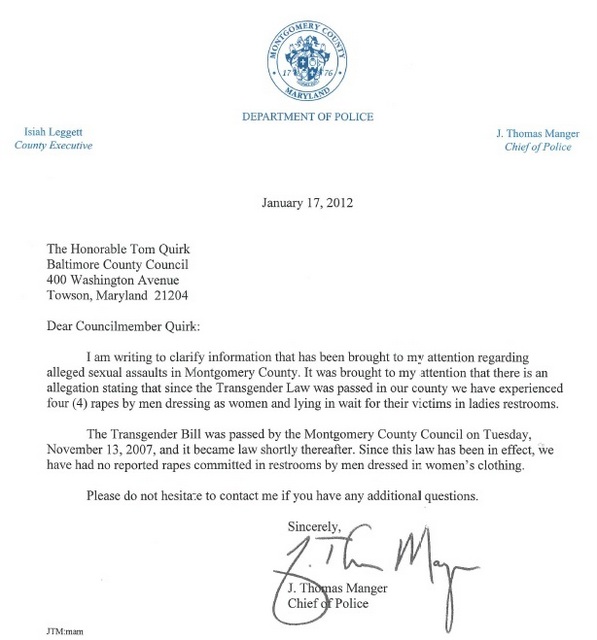
“Since this law has been in effect, we have had no reported rapes committed in restrooms by men dressed as women.”
They are even willing to exploit the very real trauma of rape and twist it to their own sick purpose in the hope that they will dupe you into doing the same:
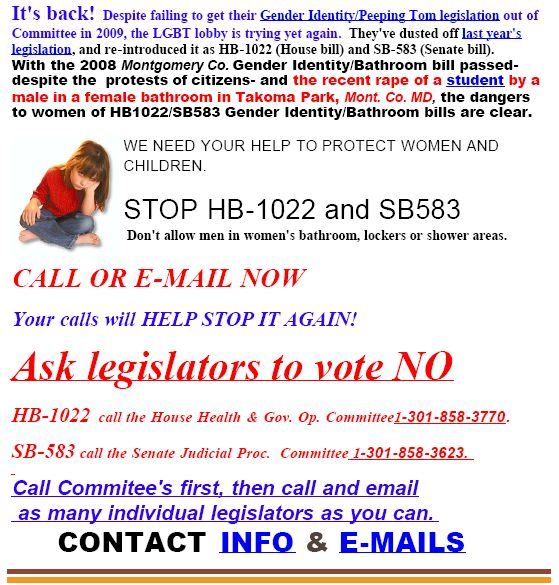
What kind of mind gladly takes up the bloody mantle of this type of intellectual hucksterism? The poor woman in this RadRight call-to-action was raped by a cisgender man and not a transwoman. The mere fact that I — a transwoman who’s dealt with being raped by a cisman — had to point this out was repugnant.
The idea the various anti-equality forces seek to set loose within your mind is always the same: separatist bigotry. The forces of anti-equality are all too happy to pick up the very same rhetorical tools that everyone from those who would seek to bar Muslims from holding office to the likes of Dr. Ruth Jacobs would use in their anti-equality efforts and it’s as perverse as it is sickening. Whether it’s a racist separatist, a homophobic separatist or a transphobic separatist, they all trade in the same rhetorical mind games. They all seek to vilify an entire group to specifically encourage you to view that group with intuitive suspicion. Separatists (whatever their flavor) have the blood of very real suffering on their hands.
Bigots will tell you all about how some white people don’t like being in the same space as black people, that some Christians don’t like being in the same space as Muslims or how some ciswomen don’t like being in the same space as transwomen. They’ll tell you that their discomfort is really, really important. In fact, they’ll look you in the eye and tell you that their discomfort is more important than your access to the 14th amendment. But that’s not how things as supposed to work here in America, is it?
Yes, a heterosexual soldier might feel uncomfortable in the same locker room as a homosexual soldier, but that’s tough shit. The soldier who views homosexuals as a whole with a wary eye has the problem, not the homosexual soldier. If a gay person behaves inappropriately after lifting DADT, then the law will deal with their bad behavior instead of reinstating DADT… no matter how much various anti-queer hate groups tie themselves into knots.
Yes, a white racist might feel uncomfortable in the locker room with a person of color, but that’s tough shit… right? We don’t segregate people by race because some white people have bigoted ideas which cause them to feel uncomfortable. No, the white bigot has the issue and they need to just fucking deal with it. If a black person behaves inappropriately after the victories of the civil rights movement, then the law will deal with their behavior instead of repealing the civil rights act… no matter how much the Klan ties themselves into knots.
If a ciswoman feels uncomfortable knowing that a transwoman might use the same restroom, then likewise, it’s tough shit. A ciswoman’s right to believe the Bathroom Meme does not trump the rights of transwomen as a whole. No, the nation shouldn’t set up a system of cis/trans segregation because some ciswomen choose to hold bigoted views which make them feel uncomfortable. If a transperson behaves inappropriately, then the law will deal with their bad behavior instead of repealing all gender equality laws… no matter how much the RadRight might tie themselves into knots.
The disgusting, fatuous and contemptible ideology embedded in the Bathroom Meme is a bigot’s favorite tool. Before you can hate, you must first learn how to vilify and dehumanize your target, so segregation can seem reasonable. The Bathroom Meme is a poison chalice wrapped in tradition and obtuse hubris; it’s an invitation to have you become the co-architect of a system which the American Psychiatric Association describes thusly:
“Discrimination and lack of equal civil rights is damaging to the mental health of transgender and gender variant individuals. For example, gender-based discrimination and victimization were found to be independently associated with attempted suicide in a population of transgender individuals, 32% of whom had histories of trying to kill themselves, and in the largest survey to date of gender variant and transgender people 41% reported attempting suicide.”
The Reality
Now, let’s step away from the memes and examine the reality for trans folk who are trying to navigate the bias the RadRight is all too happy to both create and inflame:
“I have spent so many hours avoiding public multi-stall bathrooms that I have damaged my bladder and put pressure on my kidneys. The problem was a daily one. I’d think about where I was going what bathrooms I’d have access to, how much I drank during the day, whether I’d be with people who could help stand guard…” – Response to a 2002 survey conducted by the San Francisco Human Rights Commission which found that nearly 50% of transgender respondents reported harassment or assault in a public bathroom.
“We live under the constant threat of horrifying violence. We have to worry about what bathroom to use when our bladders are aching. We are forced to consider whether we’ll be dragged out of a bathroom and arrested or face a fist fight while our bladders are still aching. It’s an everyday reality for us. Human beings must use toilets… If I go into the women’s bathroom, am I prepared for the shouting and shaming? Will someone call security or the cops? If I use the men’s room, am I willing to fight my way out? Am I really ready for the violence that could ensue?” – Leslie Feinberg, Trans Liberation: Beyond Pink or Blue, p 68 – 69
“Police officers often harass or abuse transgender and gender nonconforming people regardless of which sex-segregated bathroom they use. This harassment intensifies when coupled with the stereotyping of trans people as sexual predators. As such, the use of the ‘wrong’ bathroom . . . often results in arrests for crimes such as public lewdness, public obscenity, or public indecency. Refusing to comply with or simply questioning a police officer’s direction as to which bathroom the individual must use can often lead to charges such as resisting arrest or disorderly conduct.” – Pooja Gehi, Struggles from the Margins: Anti-Immigrant Legislation and the Impact on Low-Income Transgender People of Color, 30 WOMEN’S RTS. L. REP. 315, 326 (2009)
And it doesn’t stop with bathrooms. This level of stigma and violence is something trans folk must consider when buying clothes, too. Here’s what State Rep. Richard Floyd (R) said he’d do to a trans person if they dared to buy clothes like anyone else might:
“I believe if I was standing at a dressing room and my wife or one of my daughters was in the dressing room and a man tried to go in there — I don’t care if he thinks he’s a woman and tries on clothes with them in there — I’d just try to stomp a mudhole in him and then stomp him dry.”
To be graphically explicit about the reality trans folk face, consider this incident from Boston:
And isn’t it just awesome how transwomen are arrested for emptying their bladder? Consider this incident from Houston:
When we talk about the things Rosanne Barr said, we need to clearly address the underlying bigotry. We need to be clear when the RadRight deploys the Bathroom Meme and we need to fearlessly identify the bigot’s game when it’s being played. There is a real difference between a transwomen going into a private area to change, pee, etc. and some abuser of any flavor (cis or trans) walking into a room to parade their genitalia around. If a cisgender woman goes into the locker room and exposes herself to everyone, then there are laws to deal with her behavior. Claiming that those laws somehow magically evaporate if the person is trans instead of cis is a bigoted lie and those who propagate that lie should be called out at every turn.
About the author: Cristan Williams is a trans historian and pioneer in addressing the practical needs of the transgender community. She started the first trans homeless shelter and co-founded the first federally funded trans-only homeless program, pioneered affordable health care for trans people in the Houston area, won the right for trans people to change their gender on Texas ID prior to surgery, started numerous trans social service programs and founded the Transgender Center as well as the Transgender Archives. Cristan chairs the City of Houston HIV Prevention Planning Group, serves on the Board of Directors for the Bee Busy Wellness Center, is the jurisdictional representative to the Urban Coalition for HIV/AIDS Prevention Services (UCHAPS), serves on the national steering body for UCHAPS and is the Executive Director of the Transgender Foundation of America.
Special Note: Autostraddle’s “First Person” personal essays do not necessarily reflect the ideals of Autostraddle or its editors, nor do any First Person writers intend to speak on behalf of anyone other than themselves. First Person writers are simply speaking honestly from their own hearts.
Prop 8 Update: What’s Happening Today In The California Supreme Court
Have you, too, been missing your regular doses of our faithful defenders Olson and Boies? Since they made an appearance in the Ninth Circuit Court of Appeals nine months ago, things have been a little quiet on the Prop 8 front.
Sure, we’ve had some peripheral issues under consideration. Just last week, Judge Ware (who replaced Judge Walker upon retirement) was asked to consider whether the tapes of the trial should be released. And earlier this summer, Judge Ware confirmed that straight white men aren’t the only people qualified to be judges/make decisions about our country.
But the last time we were discussing the substance of the case it was still 2010. Congress was weeks away from voting to repeal Don’t Ask, Don’t Tell. No one would have dreamed that the Obama administration would stop defending DOMA. Marriage equality in New York was still just a dream. It was a completely different world.
The court system is slow.
Today, we return to the substance of the case.
Olson and Boies will appear before the California Supreme Court arguing about terribly important procedural matters. Remember when Judge Walker issued his 138-page opinion on how we don’t fuck up kids and we won’t keep the heteros from marrying and gay marriage is better for cities and better for the world? If you need a dose of reassurance or to feel good about the world, go read that again. Today’s arguments are not going to make you feel that way.
Instead, the California Supreme Court will be weighing in on what might seem like a mere legal technicality. The Ninth Circuit Court of Appeals has asked the California Supreme Court to answer a very specific question about the rights of the Protect Marriage folks to continue with the case. Specifically, the Ninth Circuit wants to know whether, under California law, the official proponents of an initiative measure have an interest that allows them to defend the initiative when the state chooses not to do so.
If this seems less interesting than, say, the pervasive history of discrimination against gay and lesbians, that’s because it is. No one likes the procedural technicalities of the courtroom. But the fact is, the future of the case turns upon this question.
Why does this matter?
Federal courts are courts of limited jurisdiction; as a Constitutional matter, they are only allowed to hear certain kinds of cases, and only when these cases are pursued by parties with a sufficient connection to the case. Before the Ninth Circuit can consider the substance of the case, the Court must first determine whether those challenging Judge Walker’s decision even have a right to be in the courtroom. Or in legal terminology, whether the appellants have standing. If the appellants don’t have standing, there is no case. Which is to say, if Protect Marriage doesn’t have a right to challenge Judge Walker’s decision, there is no appeal and Judge Walker’s decision will stand.
So before the Ninth Circuit can consider whether Judge Walker ruled properly, the Court must first determine whether Protect Marriage is entitled to pursue the case.
Who has standing?
Generally state officials defend state laws. As representatives of the people, state officials have standing to defend the people’s laws. In this case, though, both Governor Arnold Schwarzenegger and Attorney General Jerry Brown declined to defend Prop 8. Since California declined to defend the law, Protect Marriage stepped in to defend the law before Judge Walker. When they lost, they appealed the decision to the Ninth Circuit.
However, it is unclear whether Protect Marriage has legal standing to defend Prop 8.
Back in 1997, in the case of Arizonans for Official English v. Arizona, the Supreme Court expressed “grave doubts” about whether the sponsors of a ballot initiative have standing to defend the initiative when Constitutionally challenged. But at the time, the Court also reprimanded the Ninth Circuit, saying that “more respectful consideration should have been given to the Attorney General’s requests to seek, through certification, an authoritative construction of the [law] from the State Supreme Court.”
In essence, that is what is happening today. The Ninth Circuit asked the California Supreme Court to answer a two specific questions about California laws to help determine whether Protect Marriage has standing. If the California Supreme Court determines that Protect Marriage has either “the authority to assert the State’s interest,” or a “particularized interest in the initiative’s validity,” the Ninth Circuit could find that the ballot proponents have standing and the appeal could continue. If the California Supreme Court finds neither, it is unlikely that the Ninth Circuit will find that Protect Marriage has standing, either.
This case could have implications for ballot initiatives in general, and whether the sponsors of those initiatives have standing to defend them across the board. Since ballot initiatives are considered questionable practice by many, since they represent only popular opinion and often turn out to the disadvantage of minority groups, some consider this a good thing. Others worry that in cases like this, where the Governor and Attorney General have refused to defend the initiative, it gives the state an unintended option to “effectively veto” initiatives that they don’t like.
So what should we hope for, today?
Quite honestly, it’s impossible to say. Some people, like Santa Clara University professor and expert on the State Supreme Court Gerald Uelman, think that Protect Marriage’s chances of being granted standing might be good.
The current court, which is moderately conservative, “hasn’t put any reasonable limits” on initiatives and gives them “every benefit of every doubt,” Uelmen said. From the court’s perspective, “it would just be unacceptable to permit a total nullification of an initiative by virtue of the attorney general’s refusal to defend it,” he said.
Others say there’s no way to know.
If Protect Marriage does not have standing to continue the appeal, the case is over. Proposition 8 will be dead. California will have marriage equality, once again.
But if the case cannot continue, the results end in California. The U.S. Supreme Court will not have this opportunity to decide whether marriage equality is constitutionality required, and we will have to keep fighting this battle state by state. (At the same time, the Supreme Court will not have the opportunity to decide that marriage equality is not constitutionally required, which could set us back years in this fight).
So for now, we wait. And hope for the best, whatever that may be.
(You can also check in with Prop 8 Trial Tracker all day today for coverage of the hearing, which will begin at 8:30 AM PST.)
NOM Strikes Again: Iowa Voters Throw Out Judges, Reject Their Constitution
Leading up to the election, it seemed as if this one might offer something of a reprieve from the flood of never-ending election-induced depression cycles for those of us concerned about LGBT equality. We knew that the House was probably going to turn crimson, and the Senate was looking questionable, but for the first time in years, no one was trying to deny us rights that we already didn’t have by writing it into a state constitution. I wasn’t quite delusional enough to assume that the tide had categorically turned, but it was nice to not have our equality up for a vote, for once.
Except it kind of was, indirectly, in Iowa.
Last year, the seven justices of the Iowa Supreme Court unanimously invalidated a state law limiting marriage to one man and one woman, determining that the law violated the Iowa Constitution. This is a thing that judges do, often: they look at laws and they look at the state or perhaps the federal constitution, and if the two are inconsistent, the constitution wins and the law must fall.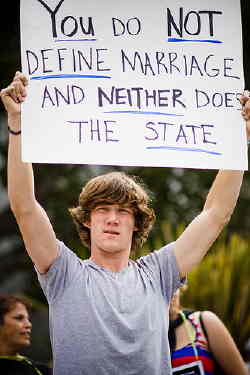
Shockingly, not everyone was thrilled with the outcome. This is also a fairly common reaction. With every court case, you have at least two opposing viewpoints — someone is going to leave not happy. But our judicial system is sound, and generally we have faith in it. The unhappy people go home to try again another day.
In this case, that meant the most recent election cycle.
Although the governor appoints Iowa Supreme Court justices with the assistance of a judicial selection committee, these justices are subject to retention elections — meaning that Iowa voters can remove justices. This process is known as “merit selection.” In theory, merit selection ensures that a justice does not remain on the bench if he or she is accepting bribes or has become incompetent or is simply not doing the work. In reality, until a week ago, no Iowa Supreme Court justice had been removed from office since this became the process in 1962. This election cycle offered voters a chance to rally against an unpopular interpretation of the state constitution. No one involved was even pretending otherwise.
NOM (National Organization for Marriage) and friends flooded the state, aggressively campaigning against the three justices up for retention this year. They were successful. All three justices were voted out; each needed a simple majority to maintain their respective positions, but only secured the support of about 45 percent of voters. Iowa will soon have three new Supreme Court justices.
This does not directly impact the status of marriage equality in Iowa. Getting rid of judges does not change the effectiveness of prior rulings. However, it may have significant implications for equality across the country, in that it sends a strong message to any judges who might be inclined to rule in a manner inconsistent with popular opinion. Presumably, most judges like their jobs; if keeping a desirable job depends on the approval of the majority, judges may be less willing to protect the rights of minorities.
Iowa is not the only place where these sorts of campaigns were launched — according to the New York Times, similarly situated state Supreme Court justices across the country were targeted for rulings on abortion, taxes, tort reform and health care. The difference, though, is that in Iowa the campaign worked. Against us, people will mobilize. Fantastic.
Those who support judicial elections claim that voter approval ensures that people have control over their judges and the system is more democratic than simple appointments; others have thoughtfully deconstructed these arguments. I’d encourage you to remember the last time you knew anything about the judges running for office. Perhaps you are all more informed than I, but the first time I saw the names of most judges running in my state was on the ballot, and at least 85 percent of the races were uncontested. Democracy in action?
As a practical matter, judicial elections give the majority control over the space where minority interests are to be protected. Our federal and state constitutions establish the fundamental rules for our governments; judges are tasked with interpreting these rules and ensuring that the government follows these rules. When the majority can threaten and remove judges because they dislike a judge’s interpretation of the rules, it is the minority who suffers.
So, How F*cked Are We, Exactly? Let’s Talk About the Midterm Elections.
We can’t pretend we didn’t know it was coming. Statistics whiz Nate Silver has been warning a bloodbath in the House for at least a month. Though he has repeatedly acknowledged the limitations he’s facing and the things his models might miss, his near-perfect track record in 2008 warrants deference.
Unfortunately, this doesn’t make the outcome any easier to take. While last night was in some ways a victory for LGBT candidates, we lost more than 50 seats in the House of Representatives, and just barely maintained a simple majority in the Senate (which is hardly encouraging given the struggles we’ve faced with almost a filibuster-proof majority). Unless suddenly our politicians decide to compromise and learn to work together again, Washington is going to have a hard time getting anything accomplished in the next two years.
Which may be absolutely devastating for the country.
We have so much we need our congressional representatives to accomplish. Officially the recession ended in June 2009, but everyone knows we’re not safe yet. The economy has consistently been one of the most important issues among likely voters. Conventional wisdom suggests that this is the reason voters ran away from the Democrats in droves; the economic recovery simply hasn’t happened quickly enough.
The problem is, though, that we need to do more, not less. Our economy is in dire straits, and we need Congress to act decisively “to get us out of our economic trap” (to quote Nobel Prize winning Economist Paul Krugman). Much of the backlash against current politicians stems from the stimulus package and abstract rage over government spending. However, economists generally agree that that the stimulus was absolutely necessary, and that the real problem is that it didn’t go far enough — we needed more government spending. Our economy isn’t going to improve by shutting down the government.
By ushering in a wave of conservative politicians, we’re also facing incredible battles on social issues – “social issues” being political code for most of the issues that matter to our community, like being able to marry or adopt. It’s unclear now where we’ll find the votes to repeal DADT or reform immigration laws or fix the prison system or protect the environment. It seems like all of the social issues may simply get pushed off the agenda.
So, from a governing standpoint, this election is anxiety-inducing.
What about from a political standpoint? We’ll leave the punditry to the pundits. Some want to claim that this indicates a loss of faith in Obama and we’re in for big changes in 2012. Others point out that the majority party almost always loses seats in the next election, and that swings of this magnitude are not entirely unprecedented. On the other hand, while it wasn’t necessarily a surprise that we lost the House majority and the number of Republican seats has increased, many are disturbed by the political extremism of those inhabiting those seats. It’s one thing to lose a majority; it’s another to lose what was a Democratic seat to Rand Paul, who opposes parts of the Civil Rights Act and whose supporters have been known to physically attack counterprotesters. Although Obama’s stated mission has been to bridge the political divide and work towards ending the polarization of American politics, it seems like that hasn’t been accomplished as well as we might like. With the advent of the Tea Party, the candidates who were elected last night are the most extreme and least willing to work together with Democrats on important issues in a long time; they’re also the least ashamed of their homophobia and racism. Maybe it means a lot and maybe it means a little and two years (or twenty years) from now, we can all sit around discussing the ultimate political implications of the 2010 midterm elections.
Did the Democratic administration have this slap in the face coming? Were people right to vote against Dems who have shown themselves to be less than committed to the change they promised? Maybe. It’s a pretty personal question. As a kind of heartrending hindsight, however, statistics have suddenly popped up all over the internet reminding us of what the Dems have accomplished, even if it wasn’t with fireworks or fanfare. How much has job growth changed in Obama’s first two years from Bush’s last year? “In 2008, we lost an average of 317,250 private sector jobs per month. In 2010, we have gained an average of 95,888 private sector jobs per month. (Source) That’s a difference of nearly five million jobs between Bush’s last year in office and President Obama’s second year.” What else have they accomplished? We’ll let Rachel tell you. [Skip to 1:40 if you’re impatient.]
At the very least, those of us who support progressive policies should take this election as an indication that our messaging needs some work. The key to winning any election is convincing the populace that your party is the best able to accomplish what they want, fix their problems and give them what they need. Somehow the Democrats, while trying their hardest to push through bills that would change lives, failed to convince voters that those changes were real – that they would be able to end a war by pulling out troops, or that they would be able to provide accessible healthcare by allowing everyone to access the healthcare system. People are voting against their self-interests because we are not communicating effectively. If we hope to advance any of our causes, we need to fix this.
On the day after, the question is always “What do we do now?” and we always feel at a loss for an answer. We already voted, which is supposed to be the ultimate exercise of power in a democracy, and that didn’t work. But it doesn’t help anyone to give up, either. In the months to come, we need to look for political capital everywhere we can find it. We need to communicate effectively with our politicians and demand the things we need; when those needs are met, we reward our candidates with our support, and when they’re not, we let everyone know. Knowledge is power, and we have to believe that people like Rand Paul were voted into office because people didn’t know how much damage they could do, didn’t know that there were other options to work towards jobs and peace and education. So we need to educate both ourselves and the people around us, our friends and families, about the way things should work, so that they can join us in making it happen. Ready? Go.
What The DADT Injunction Really Means: Something, or Nothing, Time Will Tell
 We’ve now been living in a “don’t ask, don’t tell”-free world for more than 48 hours. Doesn’t the air smell cleaner and the world seem brighter? Breathe deeply and enjoy it. It might not last. Less than three days after Judge Virginia Phillips issued a permanent injunction requiring the military to stop enforcing DADT, the Justice Department has filed a request for a stay of the injunction and a notice of appeal.
We’ve now been living in a “don’t ask, don’t tell”-free world for more than 48 hours. Doesn’t the air smell cleaner and the world seem brighter? Breathe deeply and enjoy it. It might not last. Less than three days after Judge Virginia Phillips issued a permanent injunction requiring the military to stop enforcing DADT, the Justice Department has filed a request for a stay of the injunction and a notice of appeal.
What does this mean? It’s too early to say.
With the stay, the Justice Department is essentially asking that we back the calendar up to Oct. 11 and keep it there for a while. The issue is currently pending before Judge Phillips as a procedural matter, but she is expected to deny the request. Presuming that she does, the government will request that the Ninth Circuit consider the same issue.
At that point, three judges from the Ninth Circuit will be appointed to review the request. The Ninth Circuit is generally considered to be one of the most liberal jurisdictions — but when you select three judges out of the available 26, anything can happen. Once the panel makes a decision about whether or not we can return to Oct. 11, the losing party can appeal to the Supreme Court.
Until a court grants a stay of the injunction, the injunction remains in effect. The military must stop all DADT proceedings. However, this could change at just about any moment. Unfortunately, because so many things could happen and because of the uncertainty surrounding the case, Judge Phillpips’ unequivocal ruling is not nearly as liberating as we might hope for those it most directly affects: service members.
The Service Members Legal Defense Network has issued an alert making it clear that no one should be leaping out of the closet just yet. Despite the clear judicial decree that all investigations and proceedings to discharge service members under DADT are to end immediately, lesbian, gay and bisexual service members remain vulnerable.
It is still unclear what effect the injunction will have in a practical sense. Yesterday, former sailor Omar Lopez attempted to re-enlist in the Navy; he was honorably discharged in 2006 under DADT, and now that the policy has been deemed unconstitutional he would like to return. At the recruiting office he was promptly turned away; the recruiters had no knowledge of any change to military policy.
However, in a promising development, Lieutenant General Richard C. Harding, Judge Advocate General for the Air Force, sent Air Force JAG officers an email today indicating that until the Justice Department takes action, the Department of Defense will abide by the district court injunction and immediately cease all proceedings related to DADT. Hopefully similar memos are en route to JAG officers throughout all branches of the military. Ultimately though, any such measures would be immediately reversed in the event that the Ninth Circuit were to grant the stay and agree to return to Oct. 11.

Over and over, Obama has reassured us that he doesn’t support DADT and that he wants to repeal the law as much as anyone else. When the Department of Justice initially requested that Judge Phillips postpone her injunction of DADT, Press Secretary Robert Gibbs promised that this action “in no way diminishes the president’s firm commitment to achieve a legislative repeal of DADT.” The DOJ would like us to believe that its opposition is merely situational and that it is legally obligated to defend any law that is crafted and passed by Congress. (NOTE: This is a lie).
Can we believe anyone anymore?
I want to have faith. I want to trust that Obama wants the repeal to come through Congress for strategic reasons — not because it is politically more convenient, but because it will help to secure the support of those actually tasked with implementation. If Congress repeals the law, it arguably indicates broader support for the change than the decree of a single brave judicial voice, and perhaps this will help get everyone in the military on board.
Unfortunately, my faith is crumbling with each political victory we lose and each judicial victory Obama’s administration challenges. Obama’s recent promise via Twitter that DADT will end on his watch is of little consolation to those who would like to serve openly today. I hope that someday I can reflect back on the impending appeal and recognize its wisdom, but right now it just feels like one more attack from someone who once promised to do better.p
Gay Adoption in Florida: You Lose Some/Often But You Win Some Too
If the Senate vote on Tuesday caught your attention as it did mine, you probably spent the rest of the day ready to cry. Or perhaps ready to punch things. But when ready to growl at the walls or lash out at your girlfriend, the important thing to remember is that our fight for equality has never been, and will never be, one fight. It consists of little victories, won in pieces.
And though Tuesday brought a very public and disheartening defeat, Wednesday arrived with a new little victory. A state appellate court in Florida upheld the lower court opinion striking down Florida’s 33-year ban on adoption by gay people. (To be precise, the exact language that it took the court 33 years to decree not okay: “No person who is eligible to adopt under this statute may adopt if that person is a homosexual.”)

To back up the judicial victory, Republican Gov. Charlie Crist has announced that Florida will stop enforcing the ban immediately and that the state may not appeal the case to the Florida Supreme Court (seemingly contingent on the wishes of the family at the center of the case).
Notably, this case comes just six years after a federal appellate court held that this absurd law posed no constitutional problem. Previously the court concluded “that there are plausible rational reasons for the disparate treatment of homosexuals and heterosexual[s].” These were different appellate courts (one state, one federal), but even so, that’s a tremendous shift in the judicial equivalent of a blink of an eye.
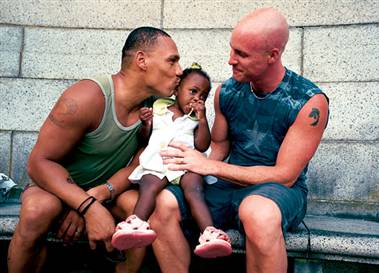
This is just one in a series of recent judicial victories. After a full trial with detailed evidentiary presentations (from our side, at least), Judge Walker concluded that there was no rational basis for limiting marriages to opposite-sex couples. Judge Tauro held that (part of) the Defense of Marriage Act is unconstitutional. Judge Phillips ruled that “Don’t Ask, Don’t Tell” violates the constitutional guarantee of substantive due process and free speech. [ETA: And just today, Judge Leighton ruled that the 2004 discharge of Air Force Reserve Major Margaret Witt under “Don’t Ask, Don’t Tell” violated her substantive due process rights and she should be reinstated immediately.]
Contrary to what some pundits would like you to believe, the judiciary isn’t really teeming with radicals. Generally, the judiciary is filled with people who are genuinely committed to interpreting the laws as they apply to particular factual scenarios. But when the facts are put on trial and judges are forced to grapple with the evidence, we are winning. And we will keep winning in little bits and pieces.
That isn’t to say that the courts will always be on our side. We will lose some of these fights, as we have lost so many before. But as long as we keep telling our stories to our friends and families, and we keep explaining why equality matters to those who don’t know they need to care, and we keep pushing our elected representatives to do better, and we keep supporting the efforts of those who can take these battles to court, we will win.

Judge Walker and the Comeback Kids: How the Gays Beat Prop 8
Judge Walker overturned Prop 8 on Wednesday and so we’ve called in our Legal Beagle Jessica to explain the nuts & bolts to ya. Like wtf is a “stay,” right?
In the past, Jessica has explained what Massachusetts’ ruling on DOMA means, the implications of having Elena Kagan on our supreme court (and now she is! so you should probably read that again) and initially began writing for us during the Prop 8 trial to answer our questions w/r/t How Do We Win This Thing?, What is Equal Protection? as well as basically briefing us on Prop 8 Trial 101.
All photos are from the rally in San Francisco in the Castro District after Prop 8 was overturned on August 4th, 2010.
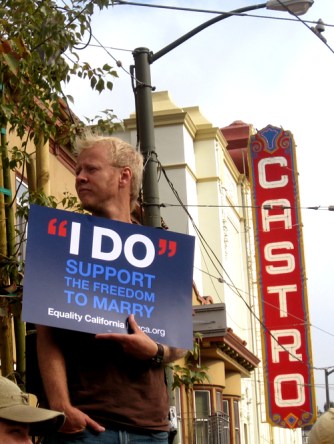
You Might Win Some But You Just Lost One
So what did Judge Walker actually decide? As you may recall, during the Prop 8 trial Team Totally Right was laying the evidentiary groundwork to make three arguments:
1. Proposition 8 violates the fundamental right to marriage as embodied in the due process clause.
2. Proposition 8 violates the equal protection clause because it discriminates based on sex.
3. Proposition 8 violates the equal protection clause because it discriminates based on sexual orientation.
To be invalidated Prop 8 only needs to be unconstitutional for one reason. However, Judge Vaughn Walker found that it is unconstitutional for all of these reasons.
According to Judge Walker, Proposition 8 “unconstitutionally burdens the exercise of the fundamental right to marry and creates an irrational classification on the basis of sexual orientation.” Within his analysis of the equal protection argument, Walker acknowledges that discrimination based on sexual orientation can take the form of discrimination based on sex, but explains that it is ultimately a separate claim.
So although he writes about sexual orientation discrimination, he notes that the arguments would be just as effective if considering the laws with regard to sex discrimination.
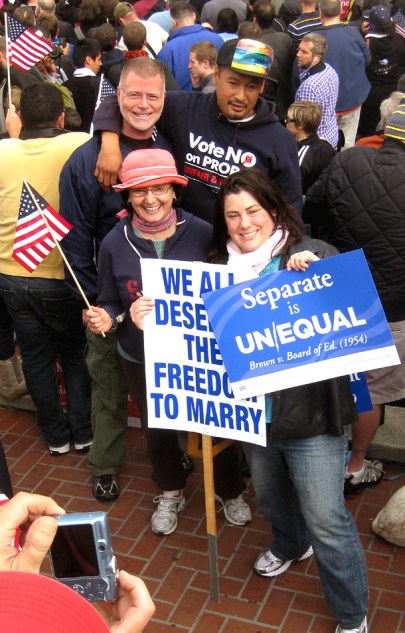
Judge Walker on The Fundamental Right to Marriage
Both sides agree that the right to marriage is fundamental; the dispute on this issue centered upon whether the couples comprising Team Totally Right were simply seeking to exercise this fundamental right or seeking recognition of a new right (by virtue of being same-sex couples).
After considering the essential characteristics of marriage (two people giving their free consent to form a committed relationship, which then forms the foundation of a household wherein the people agree to support each other and their dependents), Judge Walker concludes that marriage is marriage, regardless of the “relative gender composition” of those involved. Team Totally Right is not requesting the recognition of a new right, they just want that old ordinary right to marriage.
Since that old, ordinary right is a fundamental one, any law that burdens that right must be supported by a really good reason — the government must produce evidence that the law is “narrowly tailored to a compelling government interest.” According to Judge Walker, “the minimal evidentiary presentation” made by the H8ers just didn’t cut it. They didn’t demonstrate a compelling government interest in limiting marriage to opposite-sex couples, and in the absence of such a demonstration, Proposition 8 violates the Due Process Clause (which protects fundamental rights). The law must fall.

Judge Walker on The Equal Protection Of The Law
Despite its name, the equal protection clause does not require that the laws treat everyone equally. Instead, generally when the government passes a law that treats different people differently, the court presumes that the law is valid and will uphold it as long as the law is rationally related to some legitimate governmental interest. However, when the differing treatment is based upon membership in a “suspect class” (like race or gender) then the law will be scrutinized more closely.
During the trial, Team Totally Right advanced two complementary arguments under the equal protection clause:
1 – Proposition 8 discriminates based on sexual orientation and that sexual orientation is a suspect class warranting some degree of heightened review
2 – Even if the Judge didn’t find sexual orientation to be a suspect class warranting heightened scrutiny, Proposition 8 discriminates based on sex, and laws that discriminate based on sex are subject to heightened scrutiny
Judge Walker agrees on all points. He finds that “sexual orientation discrimination can take the form of sex discrimination” and that the two are inherently interrelated, but that sex discrimination is only one component of sexual orientation discrimination. Because Proposition 8 only eliminates the rights gays and lesbians seek to exercise, he makes the ruling based on sexual orientation discrimination, but notes that the claim is “equivalent to a claim of discrimination based on sex.”
Walker explains that the evidence presented at trial demonstrates that gays and lesbians are the type of minority that strict scrutiny review intends to protect. Among other things, he references the fact that sexual orientation is immutable and not generally something people choose, gays and lesbians have faced a long history of discrimination, discrimination still exists, irrational stereotypes persist and these stereotypes have resulted in social and legal disadvantages.
Ultimately, however, he finds that the arguments for heightened scrutiny are unnecessary, because Prop 8 cannot pass even the lowest level of review, rational basis. “Excluding same-sex couples from marriage is simply not rationally related to a legitimate governmental interest.” The H8ers claim six “legitimate” interests; Judge Walker doesn’t accept any of them. Again, without any legitimate governmental interest, the law cannot stand.
In a conclusion that might make your heart weep with joy and warrants reading even if you’ve already seen it, Judge Walker succinctly explains:
“Proposition 8 fails to advance any rational basis in singling out gay men and lesbians for denial of a marriage license. Indeed, the evidence shows Proposition 8 does nothing more than enshrine in the California Constitution the notion that opposite-sex couples are superior to same-sex couples. Because California has no interest in discriminating against gay men and lesbians, and because Proposition 8 prevents California from fulfilling its constitutional obligation to provide marriages on an equal basis, the court concludes that Proposition 8 is unconstitutional.”

If I Gave You Peaches Out of My Own Garden and I Made You a Peach Pie
So you’re a rockstar reader and already knew all of that? Good job. Gold stars for you. Those are just the highlights of the opinion, though. The true legal story goes a bit deeper. Beyond the actual words of the opinion (which are admittedly awesome), there are two aspects of the opinion that make it especially special.
First, conventional wisdom suggests that any decision on the matter at the Supreme Court will come down to the opinion of Justice Anthony Kennedy. This may or may not be true, but presumably, Chief Justice Roberts and Justices Scalia, Thomas and Alito will be against us, while Justices Ginsburg, Sotomayor, Breyer and Kagan(!) will automatically be on our side. We’ll need five Justices, though, so all eyes are on Justice Kennedy. As Dahlia Lithwick of Slate explained it, the opinion reads a little like a love letter to Justice Kennedy. Walker quotes liberally from Romer v. Evans and Lawrence v. Texas, two opinions Justice Kennedy authored. He focuses on the importance of liberty, a concept that some have suggested sits at the center of Justice Kennedy’s jurisprudence. The opinion was clearly written with the knowledge that the decision may come down to Kennedy’s opinion.
That said, conventional wisdom about the Supreme Court is sometimes wrong. Judge Walker also quotes from Justice Scalia’s dissenting opinion in Lawrence, where Scalia noted that “If moral disapprobation of homosexual conduct is ‘no legitimate state interest’ for purposes of proscribing that conduct what justification could there possibly be for denying the benefits of marriage to homosexual couples exercising ‘the liberty protected by the Constitution’?” As Lawrence established that moral disapproval of an act is insufficient to warrant upholding a law prohibiting the practice, perhaps Scalia is just waiting to cast his vote in favor of the gays. It could happen. [It won’t happen.]
Second, it’s worth noting Judge Walker’s clear, strategic divisions between findings of fact and conclusions of law. Walker wrote this opinion with the intention that it withstand review.
When an appellate court reviews the decision of a lower court, the lower court’s legal conclusions are given essentially no deference. However, the factual findings are given significant deference; an appellate court can only set aside a factual determination if the factual determination is clearly erroneous. The credibility findings are subject to even higher deference.
Knowing this, Judge Walker created an incredibly detailed factual record, featuring 80 distinct findings of fact. Among other things, he noted the following:
+ Permitting same-sex couples to marry will not affect the number of opposite-sex couples who marry, divorce, cohabit, have children or otherwise affect the stability of opposite-sex marriage.
+ Individuals do not generally choose their sexual orientation.
+ Sexual orientation is fundamental to a person’s identity and is a distinguishing characteristic that defines gays and lesbians as a discrete group
+ Prop 8 places the force of law behind stigmas against gays and lesbians, including that gays and lesbians do not have intimate relationships similar to heterosexual couples, gays and lesbians are not as good as heterosexuals, and gay and lesbian relationships do not deserve the full recognition of society.
The appellate court will be required to contend with these meticulously crafted factual findings. With such a pointed factual record, the appellate court will likely find it difficult to reach legal conclusions contrary to those of Judge Walker. This is not to suggest that the decision can never be overturned on appeal. It can and it very well might be. Judge Walker has done everything that he can to ensure that it won’t be, though.

What Happens Now?
Before the opinion was released the H8ers filed a motion to stay the judgment. Essentially, they requested that the effect of the ruling be put on hold until the Ninth Circuit has a chance to rule on the case. After releasing the opinion on Wednesday, Judge Walker granted a temporary stay, giving Team Totally Right time to respond to the H8ers request. He’ll make a final decision on the longer-term viability of the stay early next week.
Even if Walker chooses not to grant the stay, he will likely give the H8ers time to request an emergency stay from the Ninth Circuit. In essence, this means that the H8ers have several opportunities to prevent marriages from resuming immediately.
While this issue is being resolved, though, the H8ers are already looking forward to the next round. On Wednesday, they filed a Notice of Appeal. One more reminder that, although this was certainly a victory for Team Totally Right, it is but a step in the process and we still have a long way to go.

DOMA ShMOMA: How MA Is Changing the Anti-Gay Marriage Game, One Case At a Time
Recently, most of the attention around the fight for marriage equality has been focused on California. The Prop 8 trial placed stunning degrees of ignorance on public display and made for several days of outstanding recaps. We couldn’t watch it, but you know, the full transcripts are available for everyone who is inclined to read. You like to read, right? (Good, ’cause this might get a little long.)
But the Prop 8 trial isn’t the only federal litigation happening right now regarding the definition of marriage – two other cases are currently making their way through the federal courts in Massachusetts: Gill v. Office of Personnel Management and Massachusetts v. Health and Human Services (HHS).
Both of these cases challenge the constitutionality of Section 3 of the Defense of Marriage Act, which limits marriage to one man and one woman for all federal purposes.
Federal judge Joseph L. Tauro in Massachusetts just ruled that Section 3 of DOMA is unconstitutional.
Let Me Not to the Marriage of True Minds Admit Impediments
Historically, the definition of marriage has been left up to individual states.
My home state of Kansas waited until 2006 to decide that there should be a minimum age for marriage. Before that, if two 13-year-olds married, the federal government had to recognize the legality of the relationship.
Anti-miscegenation laws prohibiting interracial marriage were widespread in the South until the Supreme Court deemed them unconstitutional in 1967. Again, the federal government respected the dictates of the states: if a state declared two people married, they were married for federal purposes (and, conversely, if a state refused to marry two people, the federal government wouldn’t recognize the relationship).
This changed in 1996 when Congress passed DOMA. In relevant part, DOMA limits the definition of “marriage” and “spouse” to opposite-sex couples for all federal purposes, regardless of individual states’ laws.
But When the Tax Man Comes to the Door, Lord the House Looks Like a Rummage Sale
This is problematic. Not just because it means that the federal government refuses to legitimize your current/hypothetical-future marriage, but because when your relationship has a different status under one set of laws than another, things get complicated.
Consider everyone’s favorite subject: taxes. Pretend for a moment that you are married in California and that you and your spouse have also registered as domestic partners. Obviously you want to be good citizens and pay your taxes. And likely you’d prefer to avoid an audit and therefore you would like to file them correctly. But how?
California laws require that those registered as domestic partners combine their incomes; they can file jointly or separately, but if filing separately each person must report half of the couple’s shared income. But, for federal purposes, you can only do this when you are married to a person — and under DOMA, same-sex couples can’t be treated as married couples for federal matters. So what do you do?
Well, one couple in California asked the IRS. During the reign of Bush I, the IRS informed the couple that they had no legal grounds for being recognized as a couple. With Obama’s pledged commitment to equal rights, though, they opted to try again. The second time, the IRS informed the couple that not only could they divide their shared income, but they were actually required to do so for federal tax purposes.
So that’s easy! Confused about how to file your taxes because the state and federal governments are asking for different things? No big deal, just submit a request to the IRS for a Private Letter Ruling. Everyone has a lawyer sitting around just waiting to do this for free, right? Right.
Fortunately, according to Judge Tauro, the problem is more than DOMA making things complicated and inconvenient – Section 3 of DOMA is actually unconstitutional.
The Constitutional Problem: Equal Protection
Remember equal protection from the Prop 8 trials? Perhaps unsurprisingly, the concept makes an appearance here as well. Basically, the constitutional guarantee of equal protection doesn’t mean that the government has to treat everyone the same. Rather, when the government treats groups of people differently, it has to have a good reason why.
What counts as a “good enough” reason? It depends on how different groups are classified. When a classification is based on race, for example, a law must be narrowly tailored to meet a compelling governmental interest. When it’s based on gender, a law must be substantially related to an important governmental interest. In the vast majority of cases, though, the law need only be rationally related to a legitimate governmental interest.
With a cursory reading, it would be easy to miss the differences between the standards, but the differences here are impossible to overstate. Almost everything is permissible under the lowest level of scrutiny, while very few laws can withstand the highest level of scrutiny. Much of the time, the outcome of equal protection litigation turns entirely upon the level of scrutiny selected.
In Gill, the people challenging Section 3 of DOMA were all federal employees or the same-sex spouses of federal employees. Based on the limited federal definition of marriage, these individuals had been denied federal marriage-based benefits that were available to heterosexual married people (like health insurance and Social Security benefits). They argued that this denial violated the constitutional guarantee of equal protection.
Judge Tauro agreed.
Not only did he agree, he agreed without even considering the need for heightened scrutiny. Remember how I previously mentioned that almost every law can pass rational basis review? Not so, apparently.
According to Judge Tauro, “[t]here exists no fairly conceivable set of facts that could ground a rational relationship between DOMA and a legitimate governmental objective.” After considering the federal government’s purported interests — encouraging responsible procreation and defending heterosexual marriage — he concluded that the only purpose was to punish same-sex couples. And because “[a]n irrational prejudice plainly never constitutes a legitimate governmental interest, the law must fall.”
If a law is unconstitutional, it must fall. It doesn’t matter if it’s unconstitutional for one reason or twenty. But the more reasons you have for declaring a law unconstitutional, the more difficult it is to overturn on appeal, so Judge Tauro continued his evaluation of the law through the companion case.
The Other Constitutional Problem: The Tenth Amendment
In the U.S., Congress’s powers are both limited and strictly defined. Every federal law must be based on powers enumerated in the Constitution. Under the Tenth Amendment to the Constitution, the powers not delegated to the federal government are reserved for the states or the people. If Congress acts outside of its constitutionally granted authority, the law must fall.
In Massachusetts, the Commonwealth challenged Congress’ authority to enact DOMA. In essence, the state argued that Congress had no constitutional basis for enacting DOMA, and therefore the law interferes with the powers reserved for the states.
The federal government (in the form of Health and Human Services) argued that Congress enacted DOMA under the powers granted through the spending clause of the Constitution, which allows Congress to “provide for…the general welfare.” HHS argued that Congress has broad powers to set the terms on which it disburses federal money to the states, based on its spending power.
Confused as to the connection between limiting marriage to opposite sex couples and spending federal money? You’re not alone.
Certainly, by limiting the federal definition of marriage and excluding particular segments of the population, DOMA has effects on federal spending. For example, a state veterans’ cemetery in Massachusetts receives funding from the Department of Veterans Affairs for the burial of veterans and their spouses. To comply with DOMA and receive federal funding, the cemetery is expected to exclude same-sex spouses. Each time a same-sex spouse is denied burial rights, the federal government saves $300 in burial costs. Dollar by dollar, we’ll cut back the federal deficit by excluding same-sex spouses. Yep.
But as Judge Tauro noted, DOMA’s broad reach is not limited to provisions related to federal spending.
The ability to spend for the general welfare does not grant Congress free reign. Congress’s license to act pursuant to the spending power is subject to restrictions, notably that Congress can’t place unconstitutional conditions on the receipt of federal funding.
And what is Congress doing here? Well, as explained in Gill, Congress is demanding that Massachusetts violate the constitutional guarantees of equal protection in order to receive federal funding. And because the spending clause does not provide the authority that HHS claimed, Tauro ruled that Congress exceeded its authority and Section 3 of DOMA must fall. Again.
So What Happens Next?
The Justice Department has not yet announced whether it will appeal these decisions. Because these cases are just at the trial court level, the government has an automatic right of appeal, but such a decision is likely to be politically unpopular. By appealing the case, the Obama administration would be choosing to argue that DOMA should stand, a stance that many long-term supporters are likely to find disappointing.
That said, in many ways it is in our collective best interest for the government to appeal. Without an appeal, the case only applies in Massachusetts. For better or for worse (ha!), the case will only have significant effects if an appellate court has the chance to consider the matter.
What Would Elena Kagan Do?
Since President Obama announced Elena Kagan as his nominee to replace Justice Stevens on the Supreme Court, everyone’s been attempting to predict what type of Supreme Court Justice she might be. Will she be the progressive visionary filling the ideological void left by Justice Stevens’ retirement, or will she take a more moderate stance and work to bridge the divide between the varying factions of the Court? Does her limited public record disguise the fact that she’s secretly super-conservative, or simply make it easier to ensure her confirmation?
I understand the desire to predict her hypothetical future rulings. After all, the Supreme Court plays a significant role in shaping the country, it’s a lifetime appointment, and it would be nice to know what we’re getting before we’ve committed.
Kagan’s Record Is Light on Answers
But the reality is, you can scrutinize every words she’s ever spoken and every action she’s ever taken, and you’re unlikely to end up much closer to knowing what she might do as a Supreme Court Justice. Thus far, Kagan’s public life has been defined by her actions as an advocate — whether advising President Clinton or representing the faculty, students and institution as the Dean of Harvard Law School. Her prior actions as an advocate provide little guidance as to her personal views or her understanding of the Constitution.
Take, for example, the memo she co-authored to President Clinton in 1997. In the memo, she recommended that Clinton endorse an amendment banning late-term abortions to sustain his credibility and prevent Congress from overriding his veto. One can hardly infer her personal stance on abortion based on the memo though, or even her thoughts regarding the Constitutionality of such restrictions. Her recommendation was clearly based on a political calculation rather than any concerns regarding late-term abortions. This isn’t to suggest that she’s lacking such thoughts, just that her personal beliefs about the subject were not part of the analysis.
Unfortunately, we’re not likely to learn much more in the upcoming confirmation hearings. Prior to her last round of confirmation hearings (for Solicitor General), several Senators attempted to elicit her opinions on particular Supreme Court holdings. Her answer?
“The Solicitor General owes important responsibilities to the Court, one of which is respect for its precedents and for the general principle of stare decisis. I do not think it would comport with this responsibility to state my own views of whether particular Supreme Court decisions were correctly decided. All of these cases are now settled law, and as such, are entitled to my respect as the nominee for Solicitor General.”
Or, in the language of non-lawyers: I’m not telling.
She’s certainly not the first person seeking Senate confirmation to avoid disclosing her personal views. To quote Gail Collins of the New York Times, “Everybody knows that the Judiciary Committee hearings on Kagan will consist of senators asking for her opinion on all the hot button issues of the day, and Kagan responding that she could not in good conscience prejudge a case that might someday come before her. And then she will add something flattering about the Constitution.” It’s ridiculous — but it’s also how the system works.
The Case For Kagan
If you can’t look to her past experiences or glean anything from her future confirmation hearings, where can you look?
“[T]he core of Kagan’s experience over the past two decades has been all about moving people of different beliefs to the position she believes is correct. Not by compromise, or caving, but by insight and strength.
Who can promise that she’s not going to authorize secret prisons and offer guns to everyone and criminalize criticism of the government? When George H.W. Bush appointed Justice David Souter, he was convinced he was solidifying the conservative legacy for decades to come. Justice Souter gave us almost two decades of service and more than fifteen years of solidly liberal, rational jurisprudence. Who can say that Kagan won’t head the other direction?
Lawrence Lessig is a brilliant legal scholar, self-identified liberal and close friend of Elena Kagan. And though the last quality might prompt one to take his arguments in support of her nomination, he makes a strong case that she is the ideal candidate to join the Court. In part he argues based on information we do not share; they have been colleagues for the past 20 years and he knows her personal philosophies in a way that we cannot. He promises that she is solidly progressive. But mostly, he argues that Kagan is the best selection from a strategic point of view.
According to Lessig:
“[T]he core of Kagan’s experience over the past two decades has been all about moving people of different beliefs to the position she believes is correct. Not by compromise, or caving, but by insight and strength. I’ve seen her flip the other side…I’ve seen her earn the respect of people who disagree with her, and not by either running to a corner to pontificate, or by caving on every important issue. Kagan can see a fight; if she can see a path through that fight, keeping her position in tact, she can execute on it. And even when a victory is obviously not in the cards, she will engage the other side boldly.”
This willingness to actively engage with those who disagree is of critical importance. You see, even after this appointment, the Supreme Court is still going to have a conservative bent. For the progressive Justices to write controlling opinions that bind federal courts across the country, they’ll have to persuade at least a few more conservative colleagues to come around to a more appropriate way of thinking. And Elena Kagan just may be the best candidate for that particular task.
What About Marriage Equality?
Obviously the Supreme Court covers a broad range of subjects. But chances are, if you’re reading this, marriage equality ranks highly on your list of issues that matter. Within the next few years, the Supreme Court will almost undoubtedly be asked to decide the constitutionality of laws that prevent same-sex couples from marrying. The Supreme Court is the final arbiter of constitutionality; when five justices decree something constitutional or unconstitutional, they are correct. As one of those potential five justices on either side, Elena Kagan’s opinions matter.
So what are her thoughts?
Turning back to the questions from the Kagan’s confirmation process for Solicitor General, it’s appears that Kagan has made her opinion clear. Senator John Cornyn asked whether she believes that there is a federal constitutional right to same-sex marriage. She replied, “There is no federal constitutional right to same-sex marriage.”
Disappointed yet? Don’t be. Her statement may appear unambiguous, but it’s not.
Lawyers are tricky and detail-oriented. In providing her answer, Kagan did not state her beliefs. She stated an incontrovertible fact. As previously mentioned, the Supreme Court is the final arbiter of constitutionality. Until five Supreme Court Justices assert that a constitutional right exists, it doesn’t. The Supreme Court has not yet held that there is a federal constitutional right to same-sex marriage; therefore, no constitutional right exists. Kagan’s assertion of the facts does not in anyway reveal her personal beliefs. This might seem counterintuitive, given the clarity of the statement, but it is consistent with her ongoing refusal to provide her personal opinions.
Much like many other issues, we don’t know her personal thoughts on marriage equality. This is likely intentional and perhaps among the many reasons she was selected. Given the current highly-polarized political climate, the confirmation process is likely to run more smoothly because Kagan does not have a significant public record of controversial beliefs. Those opposed to her nomination have limited grounds on which to build a challenge.
Few will deny that she’s incredibly intelligent and has a distinguished professional record. Hopefully this will lead to a smooth confirmation process and we’ll have a new Supreme Court Justice soon.
Marriage Equality: Not Coming To a State Near You?
![]() Meet Jessica, a real live lawyer! She’s about to blow your mind with facts and explanations like it’s her job because, incidentally, it is! Jessica works for a legal publishing company where she writes and edits articles that explain legal developments to people who didn’t go to law school. You might remember her from the Prop 8 Trial, when she basically schooled us and we liked it. Aren’t you glad she gave up on her initial dream of becoming the world’s first dancing astronaut?
Meet Jessica, a real live lawyer! She’s about to blow your mind with facts and explanations like it’s her job because, incidentally, it is! Jessica works for a legal publishing company where she writes and edits articles that explain legal developments to people who didn’t go to law school. You might remember her from the Prop 8 Trial, when she basically schooled us and we liked it. Aren’t you glad she gave up on her initial dream of becoming the world’s first dancing astronaut?
See Jessica’s other stories for Autostraddle:
Prop 8 Gay Marriage Trial, Explained: Lez Legal Eagle Answers Your Lawfully Ignorant Questions
Prop 8 Gay Marriage Trial Explained Pt. 2: Equal Protection & Why They Do Those Things They Do
+
Not everyone can live in the socially progressive haven of Iowa. The vast majority of Americans are stuck in states where marriage equality is only coming in the next few years if the Supreme Court issues a nationwide mandate. (And most of the world is taking its time, too).
If you think about it for very long at all, this is likely to become really depressing and overwhelming. For as much progress as the LGBT movement has made in the past several decades, we’re still years away from equal protections under the law — more than half of the states in this country have intentionally written discrimination into their state constitutions. (Isn’t it great to feel so well-liked?)

But in the light of this frustration, it’s especially important to remember that no matter where your government may be on the road to equality, there are steps you can take to advance the cause. And with that in mind, consider the work of Project 515, a Minnesota organization working to ensure that same-sex couples and their families have equal protections under the state laws.
The Context: Minnesota Marriage Equality Is Going Nowhere Fast
Here in Minnesota, we are among the states moving too slowly toward marriage equality. We have a governor who is possessed of presidential delusions for 2012. He’s busy ratcheting up his conservative credentials and has all but promised to veto anything that smells like Democrat – so there’s no point in even trying to secure legislative support to overturn Minnesota’s Defense of Marriage Act until he’s out of office.

And unlike our sensible neighbors to the south, equality isn’t coming through our courts. Back in 1971, the Minnesota Supreme Court held that state law limited marriage to opposite-sex couples. Should someone attempt to pursue litigation through the courts, there’s a very real possibility that we’d just end up with a reaffirmation of the prior holding – which would ultimately impede our efforts. Accordingly, our local advocacy organizations have taken a strong stance against litigation as a means of reaching equality. (Note: Not everyone agrees with this stance).
Moving Forward When The State Is Stuck
Given the current situation, we only have a few options. We can postpone the ultimate goal of equality while we work to improve the political climate. We can build relationships with current senators and representatives to ensure that they vote with us once we have a better governor, and we can work to elect people who support marriage equality. And certainly, we are doing this. But this is a slow process; some bigoted governors stick around for a long time.
Alternatively, we can get creative. Clearly marriage is more than a label; it comes with legal rights and privileges. If we can’t have marriage right now, can we have some of these rights and privileges?
The Rights and Privileges of Marriage
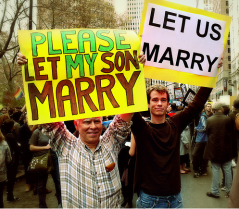
Photo by Sion Fullana
Before you can demand rights, you must understand the rights. In Minnesota, at least 515 state statutes provide rights and assign responsibilities to couples based on marriage.
Some of these seem sort of trivial. I could be with my girlfriend for the next 60 years, and I will never be concerned about my inability to legally slaughter poultry for her without getting a foodhandlers’ license. Obviously we’re both vegetarians.
But most of them matter.
These laws affect health care, professional obligations, inheritance rights and a wide range of other benefits. They protect families by providing default rules for difficult situations. And yet, as long as same-sex couples are unable to marry, these protections do not extend to their families.
Project 515: Equal Rights For Same-Sex Couples and Their Families
Equipped with this information, Project 515 is working to change the particular laws that create inequalities for committed same-sex couples in Minnesota. Clearly, it’s impossible to tackle 515 laws at once. Instead, the organization has selected specific priorities for the 2010 legislative session.
They’re working to ensure that domestic partners (two people who are of the same sex who have “assumed responsibilities for each other’s basic common welfare, financial obligation and well-being” and live together and aren’t married to other people and aren’t related) can have some of the most important rights that married people have.
“In the eyes of the law, Great Uncle Jeremiah who you’ve never met takes priority over your partner of 40 years.”
For example, if you’re married, your spouse gets to choose what happens to your remains after you die. If you’re not – that decision goes to your next of kin. In the eyes of the law, Great Uncle Jeremiah who you’ve never met takes priority over your partner of 40 years. Under the combined Final Wishes and Wrongful Death bill, which is currently en route to the governor’s desk, your partner would come first.
Generally married couples can’t be required to testify against each other in a courtroom (under the assumption that the threat of having your spouse testify against you is unlikely to improve your communication skills). The Equal Access to Justice bill would, among other things, extend similar protections to domestic partners.
A few weeks ago, President Obama directed Kathleen Sebelius to issue new rules granting hospital visitation rights for LGBT families. Rulemaking takes time, so it is not yet clear what these rules will entail – but it is likely that the Equal Access to Health Records Bill would extend these protections even further for people in Minnesota.

Photo by Sion Fullana
These are just a few of the provisions that Project 515 is working to address this legislative session. Unfortunately, even if the organization is completely successful and can pass all of its intended legislation this year, we’ll still be a long way from legal equality. But the little victories matter in very real, practical ways. These laws affect the daily lives of gay and lesbian couples in Minnesota, and the lack of legal protections often become most apparent during already terrible times.
We can’t all live in Iowa…but we also can’t all live in Minnesota. (Sad for the rest of you, cause Minnesota’s awesome). Although the work of Project 515 is clearly focused on Minnesota, though, it still matters for people outside of the state. The organization has established another path for protecting same-sex couples and their families — and this approach can be used no matter where your state might fall with regard to LGBT rights.
Marriage is important. There is no question that gradually changing the individual laws is no substitute for simply having access to all of the rights and privileges of marriage. But until that day arrives, targeting particular laws can help to protect relationships that the government won’t recognize.

